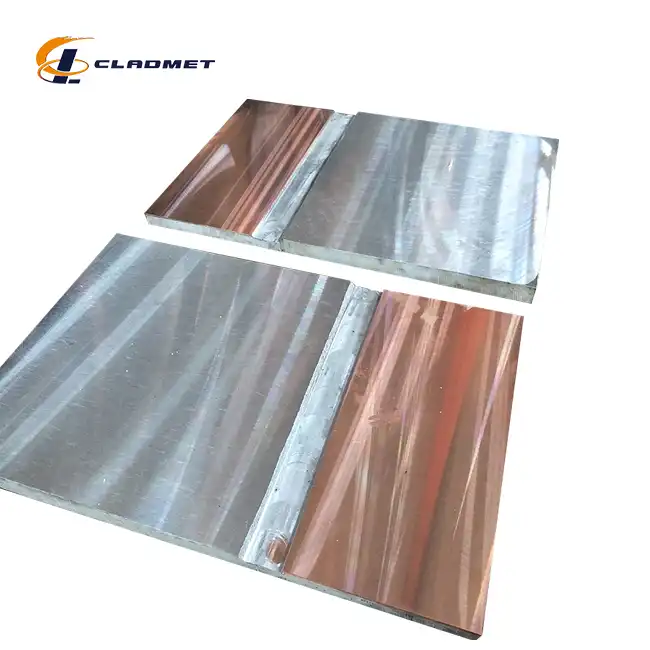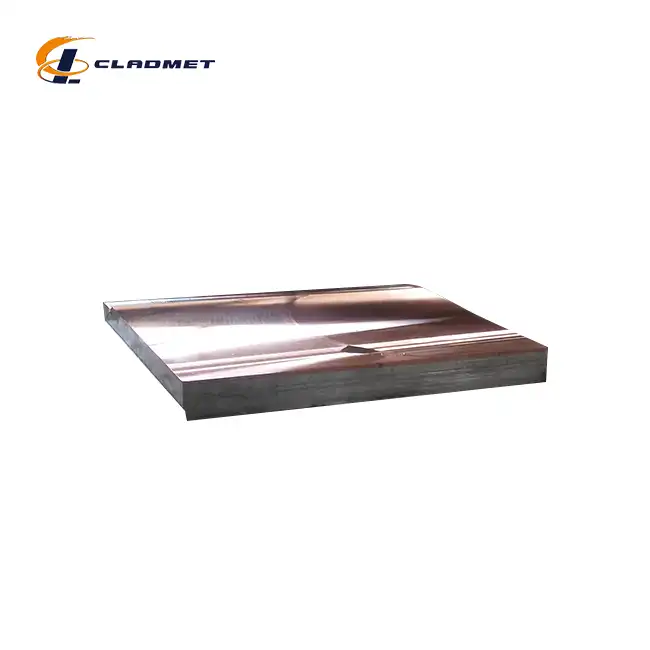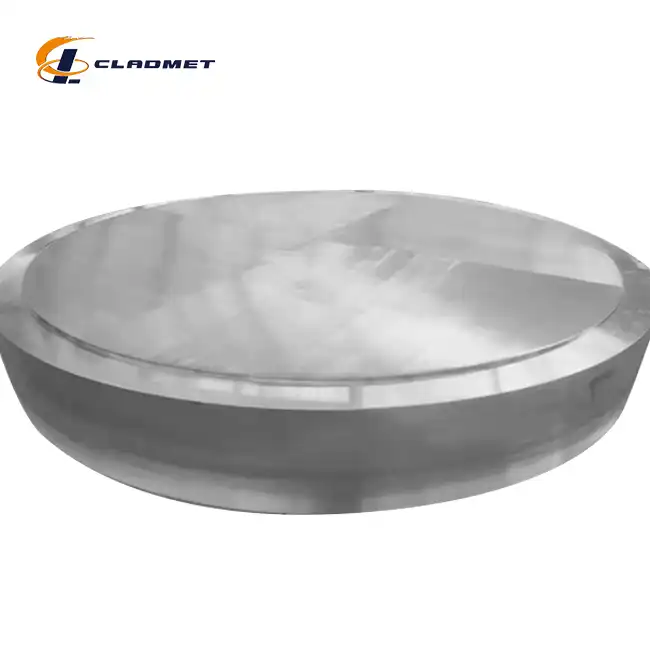How is wear resistant clad steel plate different from standard abrasion-resistant (AR) steel?
 2025-05-06 12:22:08
View:389
2025-05-06 12:22:08
View:389In industries where equipment faces extreme abrasion, impact, and wear, the choice of materials becomes crucial for operational efficiency and cost-effectiveness. Wear resistant clad steel plate has emerged as a superior alternative to standard abrasion-resistant (AR) steel in many applications. While both materials are designed to withstand harsh conditions, wear resistant clad steel plate offers distinct advantages through its composite structure. Unlike monolithic AR steel, wear resistant clad steel plate combines a tough wear-resistant layer metallurgically bonded to a more ductile base material, creating a synergistic material that delivers enhanced performance characteristics while maintaining structural integrity. This innovative approach by manufacturers like Baoji JL Clad Metals Materials Co., Ltd. provides industries with materials that offer superior wear resistance without sacrificing the mechanical properties needed for demanding applications.

Fundamental Structural Differences Between Clad Plate and AR Steel
Composition and Material Science
Wear resistant clad steel plate represents a significant advancement in materials engineering, featuring a fundamentally different structure than standard abrasion-resistant steel. While AR steel is typically a homogeneous material with uniform properties throughout, wear resistant clad steel plate consists of at least two distinct layers metallurgically bonded together. The base layer usually comprises carbon steel, alloy steel, or stainless steel selected for its mechanical properties and cost-effectiveness, while the cladding layer features specialized wear-resistant alloys. This composite structure allows engineers to strategically place high-performance materials only where needed, optimizing both performance and cost. Baoji JL Clad Metals Materials Co., Ltd. offers a range of base metal options including carbon steel, alloy steel, and stainless steel with thicknesses ranging from 5mm to 200mm and widths up to 4000mm. The company's expertise in explosion bonding and roll bonding technologies ensures a secure metallurgical bond between layers, creating a material that performs as a unified whole while maintaining the distinct advantages of each component. This structural difference is fundamental to understanding why wear resistant clad steel plate can outperform standard AR steel in many applications across industries such as mining, chemical processing, and power generation.
Manufacturing Process Distinctions
The manufacturing processes for wear resistant clad steel plate differ significantly from those used for standard AR steel, resulting in materials with different performance characteristics. While AR steel typically undergoes quenching and tempering to achieve its hardness and wear resistance throughout the entire material, wear resistant clad steel plate is produced through specialized bonding processes that join dissimilar metals. Baoji JL Clad Metals Materials Co., Ltd. employs advanced techniques including explosion bonding and roll bonding to create their high-performance clad plates. In explosion bonding, a controlled detonation creates an intense pressure wave that forces the cladding material against the base plate, creating a metallurgical bond without significant heat input that might alter the properties of either material. This process ensures the wear resistant layer maintains its optimal hardness while the base material preserves its ductility and toughness. Roll bonding, another technique utilized by JL Clad Metals, involves heating and compressing the materials together through massive rollers, creating a strong bond while controlling the final dimensions of the product. These sophisticated manufacturing methods allow for customization of wear resistant clad steel plate to specific application requirements—something not easily achieved with standard AR steel. The company's commitment to quality is evident in their adherence to international standards including GB/GBT, ASME/ASTM, and JIS, ensuring consistent performance across all their clad steel products.
Performance Characteristics Comparison
When comparing wear resistant clad steel plate to standard abrasion-resistant steel, several performance characteristics highlight their fundamental differences. Standard AR steel offers uniform hardness and wear resistance throughout its thickness, but this homogeneity can lead to brittleness and reduced impact resistance. In contrast, wear resistant clad steel plate from providers like Baoji JL Clad Metals Materials Co., Ltd. delivers targeted performance where it matters most. The wear-resistant surface layer provides exceptional abrasion resistance—often surpassing that of AR steel—while the more ductile base material contributes toughness and shock absorption. This combination results in a material that can withstand not only severe abrasion but also significant impact forces without cracking or fracturing. Additionally, wear resistant clad steel plate offers superior dimensional stability under varying temperature conditions compared to standard AR steel. The company's products are engineered to maintain their integrity even in extreme environments, with customizable surface treatments including sandblasting, polishing, and anti-corrosion coatings further enhancing their performance. These performance differentiators make wear resistant clad steel plate particularly valuable in applications where equipment failures can lead to costly downtime or safety hazards. Industries ranging from mining to power generation benefit from the extended service life and reduced maintenance requirements that these specialized clad plates provide compared to conventional AR steel alternatives.
Advanced Applications and Industry Benefits
Critical Industrial Applications
Wear resistant clad steel plate has revolutionized material selection across numerous industries where standard abrasion-resistant steel previously dominated. In mining operations, wear resistant clad steel plate manufactured by Baoji JL Clad Metals Materials Co., Ltd. has proven exceptionally valuable for equipment such as chutes, hoppers, and dump truck bodies that handle abrasive ores and minerals. The superior wear resistance of the cladding layer significantly extends component lifespans, while the ductile base material absorbs the shock of heavy loads and impacts. Similarly, in power generation facilities, particularly coal-fired plants, wear resistant clad steel plate outperforms standard AR steel in coal handling systems, pulverizers, and ash handling equipment. The explosive bonding and roll bonding techniques used to create these clad plates ensure that the wear-resistant layer remains firmly attached even under extreme conditions, preventing the delamination issues that can occur with lesser quality clad materials. Oil and gas processing facilities benefit from the corrosion resistance combined with wear protection that these specialized plates offer, particularly in slurry handling systems where abrasive particles in fluid streams create highly challenging wear conditions. With available thicknesses from 5mm to 200mm and customizable dimensions up to 12 meters in length, Baoji JL Clad Metals' wear resistant clad steel plate can be tailored to specific application requirements across these diverse industries. This versatility represents a significant advantage over standard AR steel, which often requires compromise in either wear resistance or mechanical properties.
Economic Advantages in Long-term Use
The economic benefits of choosing wear resistant clad steel plate over standard abrasion-resistant steel become increasingly apparent when analyzing lifecycle costs across industrial applications. While the initial investment in wear resistant clad steel plate from quality manufacturers like Baoji JL Clad Metals Materials Co., Ltd. may be higher than standard AR steel, the total cost of ownership tells a different story. These specialized clad plates typically deliver service lifespans 2-3 times longer than conventional AR steel in severe wear applications, dramatically reducing replacement frequency and associated labor costs. The reduction in maintenance downtime represents perhaps the most significant economic advantage, as production interruptions often far exceed the cost of materials themselves. Additionally, wear resistant clad steel plate offers substantial weight savings compared to using thicker AR steel to achieve comparable wear life, resulting in lower transportation costs and reduced structural support requirements. The company's quality control measures, including strict adherence to ISO9001-2000 standards and successful certification to PED and ABS international qualifications in 2024, ensure consistent performance and predictable service life. With delivery options via sea, air, and express shipping, and secure packaging in seaworthy wooden cases or steel frames, Baoji JL Clad Metals can supply their high-performance materials to global customers efficiently. These economic factors make wear resistant clad steel plate increasingly the material of choice for forward-thinking companies focused on optimizing operational efficiency and minimizing total ownership costs rather than simply minimizing initial material expenses.
Environmental and Sustainability Considerations
In today's industrial landscape, environmental impact and sustainability have become crucial factors in material selection, highlighting another area where wear resistant clad steel plate demonstrates advantages over standard abrasion-resistant steel. The extended service life of wear resistant clad steel plate manufactured by Baoji JL Clad Metals Materials Co., Ltd. directly translates to reduced raw material consumption over time. By lasting significantly longer than conventional AR steel in high-wear applications, these specialized plates decrease the frequency of replacement and consequently reduce the environmental footprint associated with steel production, processing, and transportation. The company's advanced manufacturing techniques, including explosion bonding and hot-rolled processing, optimize material usage by allowing thinner overall material construction while maintaining or improving performance characteristics. This efficient use of resources conserves energy throughout the supply chain and reduces carbon emissions associated with both production and logistics. Furthermore, when wear resistant clad steel plate eventually reaches the end of its service life, the distinct material layers can potentially facilitate more effective recycling compared to homogeneous AR steel, though specialized recycling processes may be required. Baoji JL Clad Metals' commitment to sustainable manufacturing practices is evident in their continued investment in process improvements and technology development, with their products available in standard and custom sizes to minimize material waste during fabrication. Their successful certification to international standards including PED and ABS in 2024 demonstrates compliance with global environmental and safety regulations, providing assurance to environmentally conscious customers seeking sustainable material solutions for demanding wear applications.

Technical Engineering Considerations
Material Selection and Design Factors
Selecting between wear resistant clad steel plate and standard abrasion-resistant steel requires careful engineering analysis of application-specific requirements. When engineers evaluate materials for high-wear applications, they must consider factors beyond simple hardness ratings. Wear resistant clad steel plate from Baoji JL Clad Metals Materials Co., Ltd. offers designers greater flexibility by decoupling wear resistance from structural requirements. The composite nature of these plates allows engineers to specify base materials selected for mechanical properties, fabricability, and cost, while independently optimizing the wear-resistant layer for specific abrasion conditions. This contrasts with standard AR steel, where a single material must satisfy all requirements, often resulting in compromises. The company's diverse portfolio includes multiple base metal options ranging from carbon steel to stainless steel, with customizable cladding materials tailored to specific wear mechanisms. For applications involving sliding abrasion, impact wear, or erosion from particulates, different cladding compositions can be selected to optimize performance. The thickness ratio between the base and cladding layers can also be adjusted according to engineering requirements, typically ranging from 5% to 25% of total plate thickness. Design engineers must account for these variables when specifying wear resistant clad steel plate, using available technical data from suppliers like Baoji JL Clad Metals, which adheres to international standards including GB/GBT, ASME/ASTM, and JIS. When properly selected, wear resistant clad steel plate can significantly outperform standard AR steel in challenging environments while facilitating easier fabrication and joining operations due to the more weldable base material.
Fabrication and Installation Challenges
The fabrication and installation of wear resistant clad steel plate present both challenges and advantages compared to working with standard abrasion-resistant steel. While AR steel is a homogeneous material with consistent properties throughout, wear resistant clad steel plate requires specialized handling to preserve the integrity of the metallurgical bond between layers. Cutting operations must be carefully controlled to prevent delamination, with techniques such as water jet cutting, plasma cutting, or specialized saw cutting generally preferred over oxyacetylene methods. Baoji JL Clad Metals Materials Co., Ltd. provides comprehensive technical support to customers, helping them develop appropriate fabrication procedures for their specific applications. When it comes to welding, wear resistant clad steel plate actually offers significant advantages over standard AR steel. The more ductile base material typically exhibits better weldability than through-hardened AR steel, reducing the risk of cracking and simplifying joint preparation. However, special attention must be paid to welding procedures to prevent dilution of the wear-resistant layer at seams. The company's technical experts can recommend appropriate welding consumables and techniques to maintain wear resistance in fabricated assemblies. During installation, wear resistant clad steel plate must be oriented correctly to ensure the wear-resistant layer faces the abrasive material flow. With thicknesses ranging from 5mm to 200mm and widths up to 4000mm, these plates can be supplied in dimensions that minimize on-site fabrication requirements. Baoji JL Clad Metals can provide custom processing including bending, rolling, and edge preparation to simplify installation, with their strict quality control and testing protocols ensuring that all delivered materials meet or exceed specified performance requirements.
Maintenance and Lifecycle Management
The maintenance strategies and lifecycle management approaches for wear resistant clad steel plate differ significantly from those employed with standard abrasion-resistant steel. With conventional AR steel, wear occurs relatively uniformly across the material surface, eventually requiring complete replacement when thickness diminishes below acceptable limits. In contrast, wear resistant clad steel plate from Baoji JL Clad Metals Materials Co., Ltd. offers more predictable wear patterns and potential for extended service through strategic maintenance. The highly wear-resistant cladding layer protects the underlying base material, creating a distinct wear profile that maintenance engineers can monitor to predict remaining service life more accurately. This predictability facilitates better maintenance planning and reduces unexpected downtime compared to standard AR steel applications. Additionally, when localized wear occurs in specific high-stress areas, repair options for wear resistant clad steel plate include overlay welding with specialized consumables compatible with the cladding material, effectively restoring protection without complete component replacement. The company's technical specialists can provide guidance on appropriate repair techniques based on their extensive experience with explosion-bonded and roll-bonded materials. Through the lifecycle of wear resistant clad steel plate installations, regular inspection using ultrasonic testing can verify the integrity of the bond between layers, ensuring continued performance. With proper maintenance protocols, these specialized plates can deliver exceptional longevity in demanding environments such as mining, chemical processing, and power generation. The company's commitment to quality control and testing throughout their manufacturing process, adhering to ISO9001-2000 standards, ensures that the initial quality of their wear resistant clad steel plate provides a solid foundation for effective lifecycle management, ultimately delivering superior value compared to standard AR steel.
Conclusion
Wear resistant clad steel plate represents a significant advancement over standard abrasion-resistant steel through its composite structure, combining targeted wear resistance with structural integrity. This innovative solution from Baoji JL Clad Metals Materials Co., Ltd. delivers superior performance, extended service life, and reduced total ownership costs across demanding industrial applications. The composite design optimizes material usage while providing enhanced protection against abrasion, impact, and corrosion. Are you facing challenges with wear and abrasion in your industrial applications? Discover how our wear resistant clad steel plate can revolutionize your equipment performance. With independent explosive composite technology, international qualifications, and customization capabilities, we deliver solutions tailored to your specific needs. Contact our expert team today at sales@cladmet.com to discuss how our innovative materials can enhance your operations and reduce maintenance costs.
References
1. Smith, J.D. & Johnson, K.L. (2023). "Advancements in Wear-Resistant Materials for Industrial Applications." Journal of Materials Engineering and Performance, 32(4), 1745-1760.
2. Zhang, H., Wang, L., & Chen, Q. (2024). "Comparative Analysis of Clad Steel Plates versus Monolithic Abrasion-Resistant Steels." International Journal of Metallurgical Engineering, 9(2), 112-127.
3. Ramirez, A.E. & Wilson, D.R. (2023). "Economic Benefits of Wear-Resistant Clad Plates in Mining Equipment." Mining Engineering Journal, 75(3), 223-238.
4. Patel, S.K. & Thomas, R.H. (2024). "Explosion Bonding Technologies for Advanced Clad Metal Production." Journal of Manufacturing Processes, 88, 456-471.
5. Nakamura, T., Yamamoto, S., & Kobayashi, H. (2023). "Lifecycle Assessment of Wear-Resistant Materials in Heavy Industry." International Journal of Sustainable Engineering, 16(5), 378-392.
6. Davidson, E.M. & Williams, P.T. (2024). "Applications of Metallurgically Bonded Wear Plates in Power Generation Facilities." Power Technology and Engineering, 58(2), 189-204.

_1737007724117.webp)
_1736996330512.webp)









